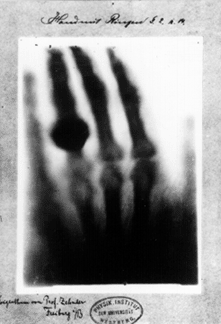X-rays

X-ray of Röntgen's wife's hand.
X-rays consist of electromagnetic radiation of wavelengths shorter than those of ultraviolet rays and longer than those of gamma rays. X-ray wavelengths fall roughly in the range from 0.01–10 nm (nanometers, or billionths of a meter).
X-rays are produced artificially when high-speed electrons collide with a tungsten or other such heavy metal target. Astrophysical sources of X-rays include plasmas with temperatures in the range 106–108 K, and charged particles moving at large fractions of the speed of light in magnetic fields.
Discovery of X-rays
X-rays were discovered and first observed in 1895 by the German physicist Wilhelm Röntgen, although at the time their nature was not understood. Röntgen found them by accident while experimenting with gas discharge (vacuum) tubes.
A week after Röntgen made his discovery, he took an X-ray photograph of his wife's hand, which clearly showed her wedding ring and her bones. This photo caused huge public excitement and aroused much scientific interest in the mysterious new type of radiation. Röntgen called it "X" to indicate it was an unknown phenomenon. The name stuck, although (despite Röntgen's objections) many of his colleagues suggested calling them Röntgen rays – a name that is still used, especially in German-speaking countries.


